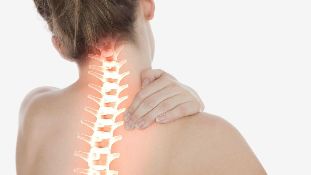
Cervical osteochondrosis - a disease of the cervical spine accompanied by degenerative and dystrophic processes in intervertebral discs.
More than 80 % of the population complain of pain in the neck. In addition, 30 % of the headache is directly linked to cervical osteochondrosis.
If you previously, this disease in the experience of older, but far more suffer from degenerative disc disease neck 20 to 30 year old patients.
Reason
The worst cause of the degeneration of the vertebrae, the neck, the following:
- lack of exercise, simply put, lack of physical activity;
- irrational nutrition;
- prolonged physical activity;
- salt deposits;
- the different injuries;
- violation of the metabolism and excess weight;
- the prolonged sedentary work (e.g., a computer), without interruption;
- incorrectly organized place to sleep (mattress, pillows);
- for long trips or constant driving.
Also risk factors are the following: hypothermia neck, heredity, hormonal disorders.
In addition, to support the degenerative cervical disc disease, autoimmune diseases such as rheumatism, systemic lupus erythematosus.
The disease develops slowly, but is prone to the progression.
Symptoms
Main symptoms of degenerative disc disease neck:
- pain. Both can be minor or severe pain in the neck;
- numbness. Usually this is the area of the arm, shoulder, scapula, neck, maybe a feeling of tingling. The characteristic of the rop in the neck while turning the head;
- noise, ringing in my ears. Sometimes hearing loss;
- migraine, headache, muscle weakness in the hands and feet;
- nausea, shortness of breath. It seems that you can't breathe, this leads to a lack of oxygen;
- blurred vision. Observed, blurred vision, reduction of visual acuity, there are the so-called "flies" before the eyes of;
- the instability of the blood pressure. Patients affected by high or low pressure, the result is dizziness.
Like the pain, then most often followed by the patient, when turning the head, or after sleep, minimal exercise your hands, cough or sneeze. Pain, so to speak, to "give" in the occipital region, shoulders, arms. If you tilt your head forward, and often pain under the shoulder blade.
Diagnosis
The diagnosis of cervical degenerative disc disease, you can consult an orthopedic doctor or a neurologist. He will conduct inspection and survey of the patient, they send the x-rays of the neck more angle. In some cases it may be necessary to MRI examination or MRI diagnosis.
Treatment
Cervical osteochondrosis you need a long, systematic, and gradually treatment. Especially the therapy aims to eliminate the pain inflammation.
In the early stages of the disease enough manual therapy, therapeutic exercises. The more running - to the medicine.
It is also important to create the conditions for the regeneration of damaged tissue, to do this, use the products, the vitamin B in the form of injections or tablets.
It must be noted that the system of work, rest, take care of comfortable sleep, not to lift weights or to quit the addiction.
Complications
Osteochondrosis of the cervical-many believe are more insidious disease. Finally, since the cervical vertebrae are located close to each other, then the smallest deformation of the compressed nerve roots, and blood vessels. In the end, disturbed cerebral circulation, which is the headache, the migraine. In special cases, filled with ischemia or spinal cord, and stroke.
The risk, as well as the circulatory system. Some people observed a cardiologist, because my heart hurts, constantly "churning" high pressure, then the reason lies in osteochondrosis of the neck.
Also due to the compression of nerve endings, the patient is suffering from hearing, vision, disturbed coordination of movements.
Special form, and without treatment, the hernia formation, treatment of which required surgical intervention.
The elderly cervical osteochondrosis is often combined with deforming arthrosis of the cervical, spine wear, etc.
Prevention
To avoid the cervical degenerative disc disease, you need to lead a healthy lifestyle, healthy diet, perform regular exercise. A big role in the proper organization of the workplace and the observance of the scheme of work, rest.


































